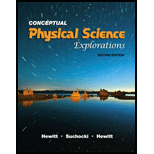
Concept explainers
The periods of the Paleozoic era.
Answer to Problem 11RQ
The Paleozoic era is divided into six periods that are the Cambrian, Ordovician, Silurian, Devonian, Carboniferous and Permian period.
Explanation of Solution
The Paleozoic time era began around 543 million years ago, and it lasted about 295 million years ago.
During this time, sea-level fluctuations occurred several times and several areas of the Earth were covered by the sea and oceans due to an increase in the water level. And this results in the evolution of marine life in this era. So the new feature evolved and it is later named as shelled organism. It is more informative than Precambrian time.
The Paleozoic era is divided into six periods that are the Cambrian, Ordovician, Silurian, Devonian, Carboniferous and Permian period.
Conclusion:
Therefore, The Paleozoic era is divided into six periods that are the Cambrian, Ordovician, Silurian, Devonian, Carboniferous and Permian period.
Chapter 29 Solutions
Conceptual Physical Science Explorations
Additional Science Textbook Solutions
Essential University Physics: Volume 2 (3rd Edition)
Physics (5th Edition)
Applied Physics (11th Edition)
Physics for Scientists and Engineers: A Strategic Approach with Modern Physics (4th Edition)
Life in the Universe (4th Edition)
College Physics: A Strategic Approach (3rd Edition)
 College PhysicsPhysicsISBN:9781305952300Author:Raymond A. Serway, Chris VuillePublisher:Cengage Learning
College PhysicsPhysicsISBN:9781305952300Author:Raymond A. Serway, Chris VuillePublisher:Cengage Learning University Physics (14th Edition)PhysicsISBN:9780133969290Author:Hugh D. Young, Roger A. FreedmanPublisher:PEARSON
University Physics (14th Edition)PhysicsISBN:9780133969290Author:Hugh D. Young, Roger A. FreedmanPublisher:PEARSON Introduction To Quantum MechanicsPhysicsISBN:9781107189638Author:Griffiths, David J., Schroeter, Darrell F.Publisher:Cambridge University Press
Introduction To Quantum MechanicsPhysicsISBN:9781107189638Author:Griffiths, David J., Schroeter, Darrell F.Publisher:Cambridge University Press Physics for Scientists and EngineersPhysicsISBN:9781337553278Author:Raymond A. Serway, John W. JewettPublisher:Cengage Learning
Physics for Scientists and EngineersPhysicsISBN:9781337553278Author:Raymond A. Serway, John W. JewettPublisher:Cengage Learning Lecture- Tutorials for Introductory AstronomyPhysicsISBN:9780321820464Author:Edward E. Prather, Tim P. Slater, Jeff P. Adams, Gina BrissendenPublisher:Addison-Wesley
Lecture- Tutorials for Introductory AstronomyPhysicsISBN:9780321820464Author:Edward E. Prather, Tim P. Slater, Jeff P. Adams, Gina BrissendenPublisher:Addison-Wesley College Physics: A Strategic Approach (4th Editio...PhysicsISBN:9780134609034Author:Randall D. Knight (Professor Emeritus), Brian Jones, Stuart FieldPublisher:PEARSON
College Physics: A Strategic Approach (4th Editio...PhysicsISBN:9780134609034Author:Randall D. Knight (Professor Emeritus), Brian Jones, Stuart FieldPublisher:PEARSON





